Visiting the Taj Mahal was one of the most surreal experiences I’ve ever had in my life. Strangely, it took me weeks of pondering to figure out why. I’ve seen beautiful buildings before and I’ve seen natural marvels that absolutely blow the Taj Mahal out of the water with their sheer size and magnitude. What makes this place so special? Then I had an epiphany. It finally dawned on me why I froze in my tracks with goose bumps when I first saw it: it’s the only man-made creation I have ever seen that fully embodies what it means to truly love someone. When I talk about love I don’t mean that Shakespeare style Romeo and Juliet, “star-crossed teenager I’m full of hormones and I just met you a week ago love crap” I mean the”I love you with every ounce of my being so I’m going to create something so powerful and beautiful people will fly half way around the world to see it” kind of love. The kind of love that makes a man “employ” 20,000 people and almost empty his entire royal coffers just to build something that the woman he loved wouldn’t ever even see. Once I put it in that context in my mind, it’s obvious why I (a self-proclaimed rambler) found myself speechless (and wordless) for weeks after seeing one of the greatest feats of architecture in the world. The Taj Mahal truly does prove the power of love in stone.
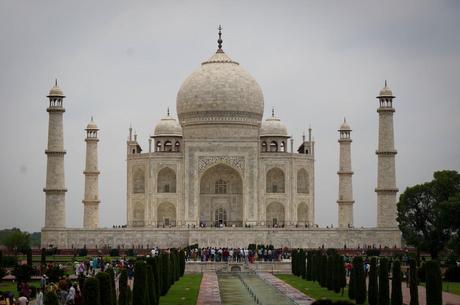
To understand why the Taj Mahal is so incredible and so powerful you have to really understand everything that went into the construction of it. If you read Lauren’s blog post on the Taj Mahal, you already know the backstory as to what drove Shah Jahan to build such a masterpiece to honor his deceased beloved. What I find crazy amazing is just how much detail, care, and focus went into constructing one of the finest buildings this world has ever seen; not to mention the amazing compound surrounding it. Many travelers know about and want to see the Taj Mahal itself, but the beauty, grandeur, and enormity of the site hit you before you ever even see the Taj. First of all the mausoluem is only one out of 3 buildings on that end of the site, and the entry gate to the Taj is considered an architechtural feat on its own. In addition to the buildings the grounds themselves were actually laid out in homage to the Koran. There are two designated halves: one to represent the world of the living, which included a bazaar, and the other, beginning at the great gate, to represent and honor the world of the dead. Once inside the main gate there is a garden that is bisected by two rivers that represent the flowing waters of Paradise. Then flanking the actual Taj itself are two more buildings; a mosque and a second building (the Jawab) that are actually built as mirror images. The entire site is surrounded by 3 walls with the fourth side left open to the river behind the Taj Mahal.
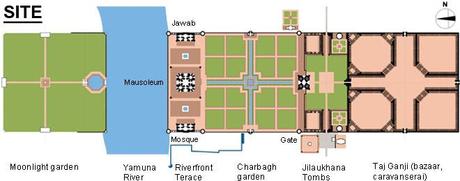
image source
When you consider that this was all put together in the 1600′s, it’s mind boggling to see the level of detail dedicated to the site design. One other interesting engineering fact, because the Taj Mahal is directly on a river, the entire foundation is actually supported by a grid of pylons below it to protect it from sinking as the height of the river and water table adjust. When we first arrived at the site of the Taj Mahal and entered the first bazaar, I was surprised by the beauty and sheer size of the area. Then we turned a corner and caught a glimpse of the main entry gate, I was floored.
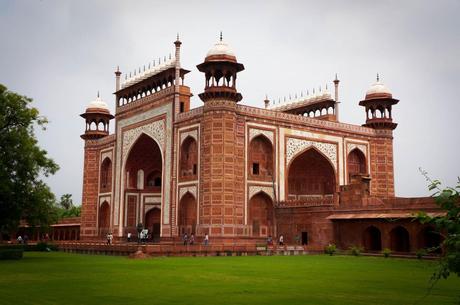
The Main Gate leading to the Taj Mahal
The main gate mirrors many of the same architectural features that are seen in other famous Mogul buildings. The red stone is the same type of stone used in the Agra Fort, renovated and buit up by Shah Jahan’s grandfather, as well as the famous Jama Masjid and Red Fort in Delhi which were also commissioned by Shah Jahan. The front of the gate uses an inlay technique where black stone was inlayed in the white marble with verses from the Koran inviting visitors into paradise. Interestingly the script is actually larger at the top than it is on the sides in order to create the illusion of uniformity when standing in front of it.
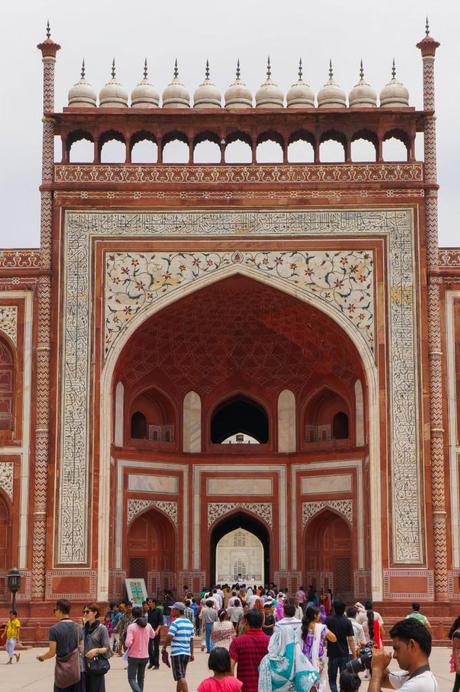
The Taj Mahal main gate is over 93 feet tall
The gate also feature 22 white domes, one representing each year that it took to build and complete the Taj Majal. The level of inlay detail is incredible, a fitting invitation into this worldly representation of love and paradise.
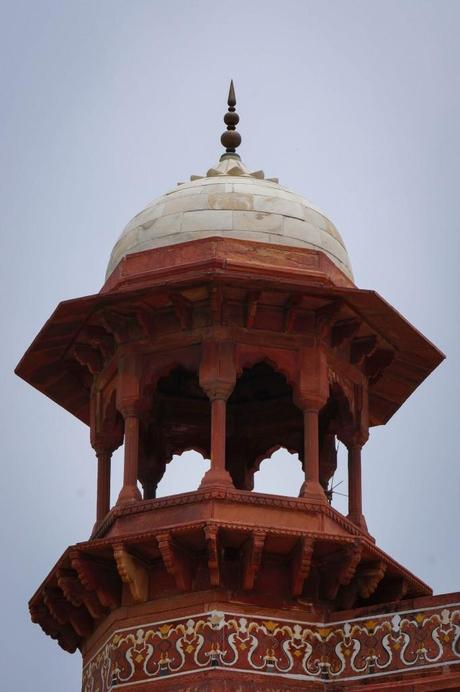
One of the 22 marble capped domes featured on the gate
As you enter the main gate there is an interesting optical illusion that occurs. As you get closer to the Taj Majal, it actually appears to recede into the distance magically, an effect created by the grounds and surrounding structures coming into view.
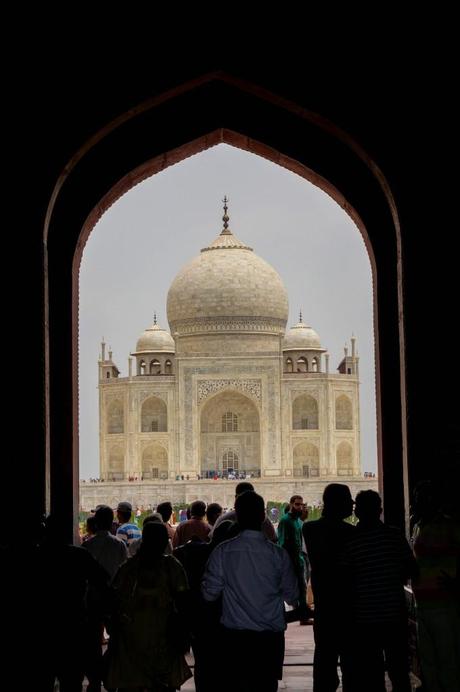
It gets “smaller” as you get closer
It was at this point that it all began to overwhelm me. It was like walking onto the set of a fairytale. I always knew the Taj Mahal was a real place and a real thing, but it’s only something I’ve seen in pictures or on TV. Stepping through that gate and staring at the Taj Mahal felt like a step back in time and into a whole other world.
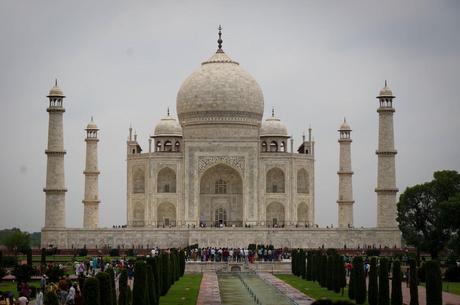
Yes, it really ia a real place!
Other than the way people were dressed (and their ubiquitous cameras and cell phones ) it could have been the year 1750 and I imagine it would have looked all the same. As if to reinforce this feeling of timelessness, this cart cut in front one of the shots I was trying to take. How can it be that they are still using the same technology to maintain the Taj Mahal as they used to build it over 400 years ago?

This happened by accident…
Once I recovered from being overwhelmed, we made our way into the site to get a closer look at this testament to one man’s love for his favored wife. As we drew closer to the Taj Mahal we were able to get better look at the 4 minarets surrounding it. In another surprising use of optical illusion, the minarets are actually built at a slight angle outwards in order to look straight when viewed from a distance.
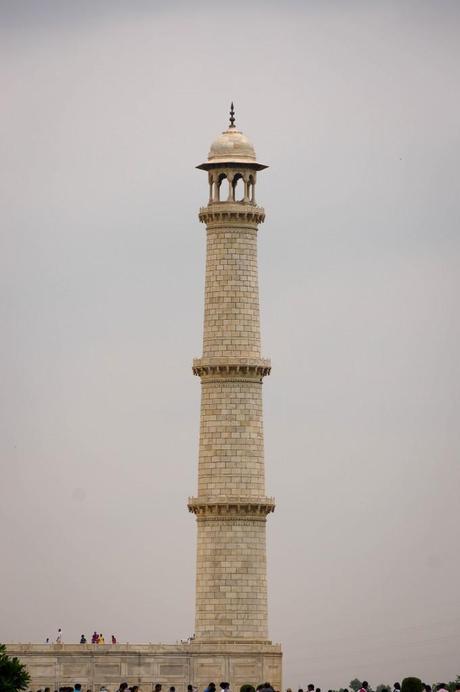
This minaret actually intentionally tilts outward.
At one point in time visitors could climb up to the tops of these towers of marble, but sadly, a few too many confused individuals thought jumping off of them would be a good way to prove their love for each other hence they have been closed. As you make your way towards the Taj Mahal, the first building you come to is the mosque that was built on it’s left side. Fascinatingly, there is a second building called the Jawab on the opposite side of the site built in the mosques mirror image with only a few minor changes. The symmetry this creates add to the surreal otherworldly feeling that fills the site.
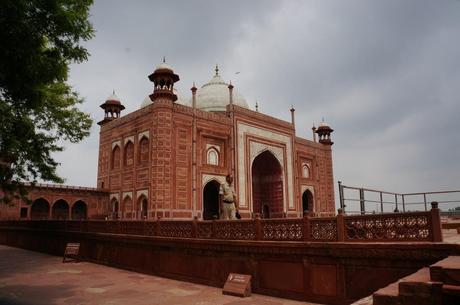
There is a Mosque to the left of the Taj, an impressive building in it’s own rite.
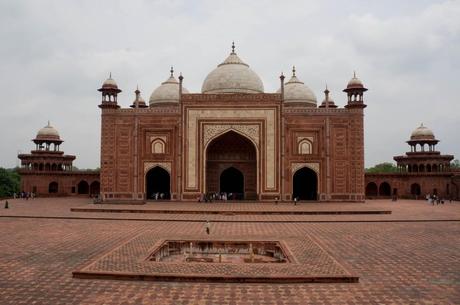
The Jawab is it’s mirror image on the right.
Once you get past how large the whole place is, you really get to appreciate how much love and attention to detail went into it. It seems as if every surface is covered with intricate carvings, inlays, and overlays. Considering that all of this is made from marble and precious stones that were carried in from hundreds of kilometers away makes this feat all the more impressive.
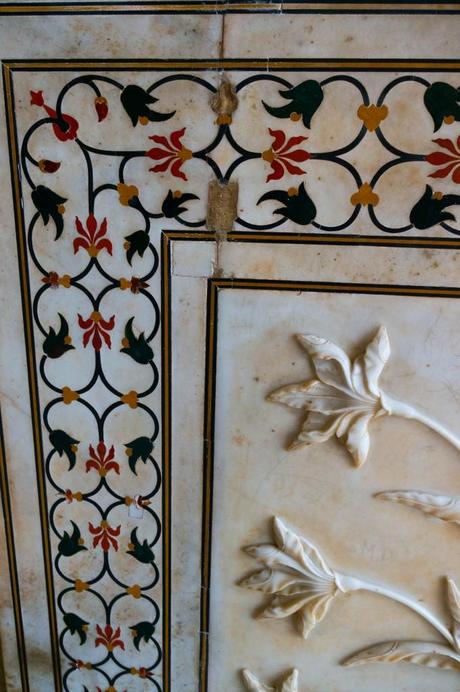
This same pattern is repeated thousands of times over. Each flower professing their love.
One of the things I found most surprising is that the entire Taj was first built of red sandstone and then covered completely with this marble work. To give you an idea just how detailed and precise this kind of work is, look at this broken away section of the back wall. This herringbone pattern isn’t a few millimeters thick, it actually goes through the entire slab.
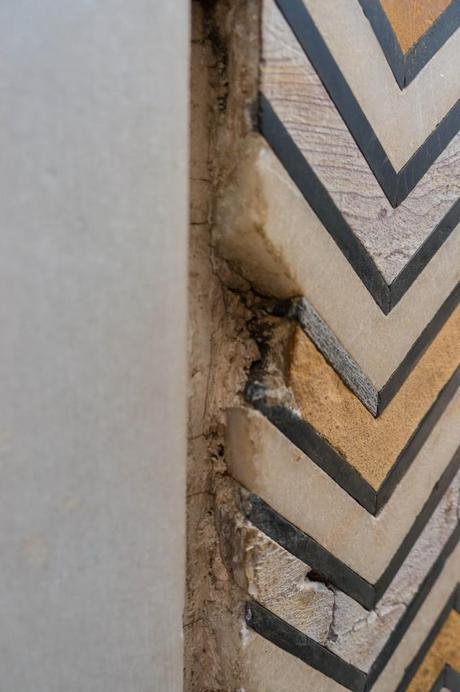
That’s dedication to perfection.
As you come to the front of the Taj Mahal and are about to enter the building, the main entrance towers in front of you. The same scrollwork technique used on the main gate, is repeated again on the front of the Taj. This time though, it’s done completely in marble, black stone, and semi precious stones.
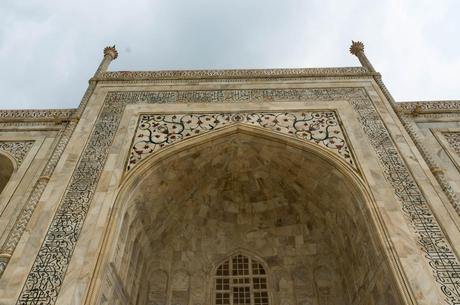
The sheer size is daunting.
The detail, even on this scale is once again brilliant.
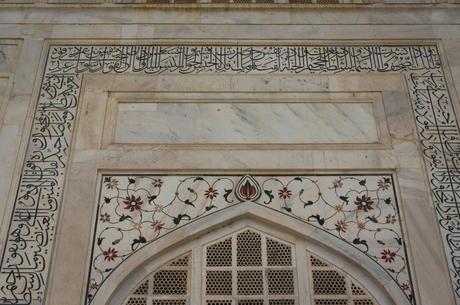
The “screen” is made of carved marble as well
The love and attention to detail of the Taj is present all the way to the very top. The impressive dome is capped by a finial that was once made of solid gold.
